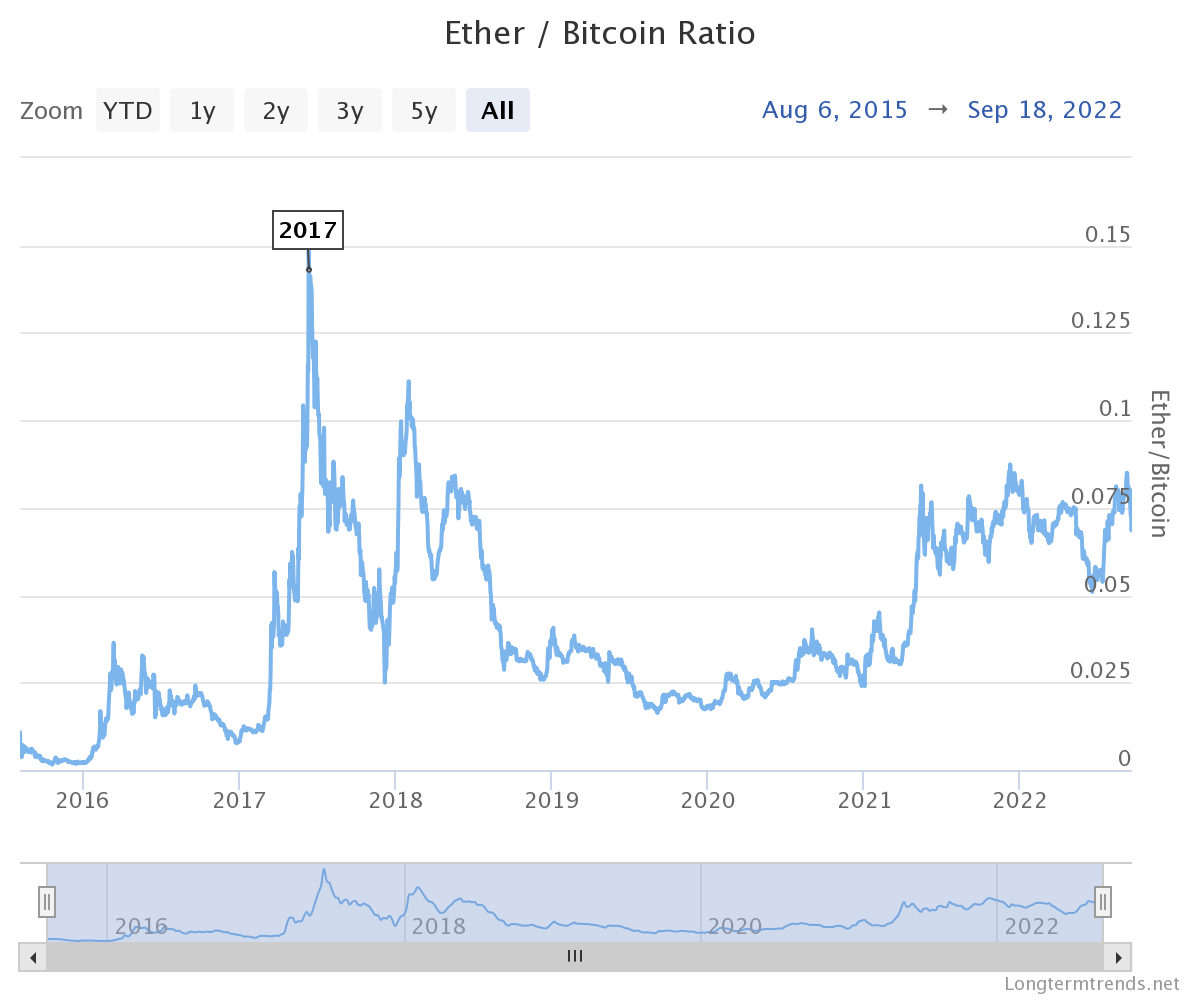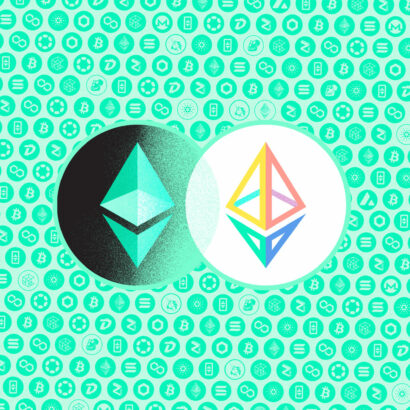Bitcoin vs. Ethereum
You Should Probably Know How These Blue Chip Cryptos Stack up Against Each Other.
Bitcoin and Ethereum get a lot of attention from crypto investors, developers an even regular people are paying attention to them.
Both Bitcoin and Ethereum have their own unique features and benefits, but is one better than the other?
In this article, we’ll compare Bitcoin (BTC) and Ethereum (ETH) in just enough detail to help you understand each of these advantages and disadvantages — hopefully you can decide whether one is better or even if either of them is worthwhile considering right now.
Key Takeaways
- Bitcoin (BTC) is a cryptocurrency designed to be a “store of value”
- The Bitcoin blockchain is a Proof-of-Work blockchain
- The Bitcoin blockchain only supports BTC operations
- Ethereum (ETH) is a cryptocurrency designed to be “programmable money”
- The Ethereum blockchain supports ETH operations, allows for Smart Contract deployment and the creation of DeFi applications
- The Ethereum blockchain is a Proof-of-Stake blockchain
Jump to:
Introduction
Key Differences between BTC and ETH
Proof-of-work vs Proof-of-stake
The case for Bitcoin in 2022
The case for Ethereum in 2022
Performance vs USD
BTC vs ETH charts
Which should you buy?
Conclusion
Introduction
What is Bitcoin?
Launched in 2009 by mysterious creator, Satoshi Nakamoto, Bitcoin is the world’s first successful cryptocurrency.
Bitcoin is a peer-to-peer virtual currency designed as an alternative to traditional or fiat money. It can be used to make purchases, trade for other cryptos and as an investment.
BTC lives on the Bitcoin blockchain, a decentralized network that operates without the need for third-party entities like banks or governments. The Bitcoin blockchain allows BTC transactions to be verified, stored, and ordered immutably and transparently.
The Bitcoin blockchain uses a Proof-of-Work (PoW) consensus mechanism for transaction verification and network security. PoW also enables new BTC to be introduced into public circulation.
Bitcoin has a supply cap of 21,000,000 BTC coins. There are currently over 19 million BTC in circulation. 19,117,550 at the time of this writing.
What is Ethereum?
Vitalik Buterin, one of the co-founders of the Ethereum blockchain is credited with conceiving Ethereum.
Ethereum is the blockchain behind the ETH (or Ether) cryptocurrency, and the second largest cryptocurrency by market cap. The Ethereum blockchain is one of a few blockchains that offers more than just a place where ETC tokens live and operate.
The Ethereum blockchain is a Smart Contract platform that allows for dApp development. It can be used by anyone to create any secured digital technology.
Launched in 2015, the Ethereum blockchain started as a PoW blockchain. However, as a PoS blockchain, Ethereum has ceased to rely on miners to validate transactions and switch to validators.
Ethereum does not currently have an issuance limit or max supply cap.
At the time this was written (August 2022), there were 121,904,461 ETH in circulation.
What are the Main Differences between Bitcoin and Ethereum?
Perhaps the most notable difference between these two cryptos is utility.
Bitcoin is primarily used as a digital currency whereas Ethereum can offer much more than that. In addition to being used as a cryptocurrency, Ethereum also runs Smart Contracts which allow developers to program DeFi apps, launch NFTs and even create other cryptocurrencies.
Another key difference is the mining process.
Bitcoin mining – called Proof of Work (PoW), requires expensive hardware and consumes a lot of energy.
Ethereum mining, on the other hand, is more efficient and can be done using cheaper GPUs. Also, Ethereum has a much faster transaction speed than Bitcoin. This is because Ethereum uses a different consensus mechanism than Bitcoin
As of September 2022, these two blockchains are using different consensus mechanisms for transaction validation and security. While Bitcoin continues to support the Proof of Work, “the Merge” has seen the Ethereum network move to a Proof of Stake algorithm.
Proof of Work vs. Proof of Stake
Proof of Work
Proof of Work (PoW) is a consensus mechanism that requires miners to compete to solve complex mathematical problems to verify transactions and add new blocks to a blockchain. The mechanism, though effective, is costly and energy intensive.
Miners require a lot of expensive, specialized mining hardware (ASIC) that consumes a lot of electricity. Only the first miner to solve the computational problem gets to add a new block to a blockchain and receive the reward.
Advantages of Proof of Work
Among the many reasons Bitcoin continues to stick with the Proof of Work consensus mechanism are;
- High security: Proof of work has been tried and tested and proven to hold its own when it comes to blockchain security.
Its dependence on computational capabilities is one of the many reasons it’s a highly secure consensus mechanism. - Decentralized: the block reward incentive attracts miners to Bitcoin mining.
The more miners join the network the more decentralized it gets.
Disadvantages of Proof of Work
- Expensive: Mining hardware required to mine crypto on a PoW blockchain is not cheap.
Not many people can afford to participate in Bitcoin mining. - Energy use: Bitcoin mining hardware consumes a lot of electricity and Bitcoin is criticised for its negative environmental impact.
Proof of Stake
Proof of Stake (PoS) uses validators to verify transactions and add new blocks to a blockchain. Validators are participants in a PoS blockchain who’ve staked some of their tokens. The more tokens a participant stakes the higher their chances of getting selected to add a new block and earn the block reward.
Proof of Stake unlike Proof of Work does not require expensive mining hardware that consumes massive amounts of electricity, participants only need crypto coins they can stake.
Advantages of Proof of Stake
Some of the official reasons why Ethereum is switching to the Proof of Stake consensus mechanism include,
- Energy efficiency: Proof of Stake does not require energy-intensive mining equipment to validate and add new blocks to a blockchain.
- Low entry barrier to block validation: Because no expensive mining equipment is required, any crypto holder can stake their coin and stand a chance of winning the block reward.
Disadvantages of Proof of Stake
While considered a better alternative to Proof of Work, Proof of Stake does have a few disadvantages.
- New consensus mechanism: Compared to PoW, PoS is a new consensus mechanism that is yet to fully prove its capabilities.
- Centralization risk: Validators with a lot of cryptocurrencies can easily hold much influence on a Proof of Stake system.
The Case for Bitcoin
Bitcoin as a Hedge against Inflation
During the pandemic, many governments printed a lot of money to help their economies. As we all know, the more money that is introduced into circulation, the higher the prices of goods get, leading to inflation.
With the value of the US dollar rapidly depreciating, many people are looking for alternative investments. Cryptocurrencies like BTC have become the best option in many of their eyes.
Bitcoin has historically stood as a hedge against inflation, in part this is due to its max supply being limited to 21 million coins. No one can ever “print” or introduce any more Bitcoin after the last block is mined. This is predicted to happen in the year 2140.
Many investors believe BTC will function like gold, and over time be proven as a way to hedge against the rising prices of consumer goods and services.
Bitcoin and Web3
Web3 is a new version of the internet that runs on blockchain technology, hosts decentralized applications, and uses cryptocurrencies. It is also known as the third generation internet.
Web3 aims to remove control from large corporations and give it back to the users. Among other things, users will have full control of their data.
Bitcoin is among many cryptocurrencies that are to benefit from Web3 if it does become a reality. Web3 is expected to have native payments where users will seamlessly spend and send cryptocurrencies to each other.
The Case of Ethereum
The Ethereum Merge
The Ethereum Merge was the most highly anticipated crypto event of 2022. The Ethereum mainnet merged with the Beacon Chain, transitioning it from a Proof-of-Work blockchain to a Proof-of-Stake blockchain on September 15, 2022.
According to Ethereum, the Merge will benefit the Ethereum network in several ways including dropping energy consumption rate by 99.95%.
It should also lead to better scalability.
Ethereum and the Crypto Ecosystem
Ethereum continues to be the go-to platform for various crypto projects. The network leads the decentralized financial market with the bulk of NFT projects running on it as ERC-721 coins. As of April 2022, there were a total of 80,300 NFT collections on the Ethereum blockchain.
Many Play-to-earn blockchain-based games, including Decentraland, Axie Infinity, and League of Kingdoms, are built on the Ethereum blockchain. The games also enable the network and ETH to benefit in the Metaverse.
Staking and Earning
Staking is a popular way to earn passive income from crypto assets. It involves committing a certain amount of your crypto asset to support a blockchain network and validate transactions.
By helping support a blockchain’s operations you earn rewards, which can be more crypto or voting rights.
Staking is only available to cryptocurrencies that use the Proof of Stake consensus mechanism. Therefore it can benefit ETH holders but not BTC.
Several platforms including Lido, Rocket pool, Coinbase, Binance, and Kraken, already support ETH staking. This is in advance of the transition to a Proof of Stake blockchain.
Rocket Pool, for example, allows users to stake as little as 0.01ETH and earn. Users can choose to stake and run nodes, enabling them to earn up to 4.88% APR or stake without running a node and earn up to 4.03% APR.
It is worth noting that, currently, staking ETH is different from staking other PoS cryptocurrencies.
When you stake the digital coins you are committing them to a platform until the Ethereum 2.0 upgrade is complete. It’s expected to happen by the fall of 2022, but there are no guarantees that this will happen on time or without issues. You can earn from staking ETH, but will not be able to use it for anything else until after the Merge.
Performance vs. USD
BTC vs. USD
BTC has outperformed USD by a significant margin in recent years. In fact, BTC has been one of the best performing assets in the past decade.
While the US dollar has lost over 95% of its purchasing power since 1913, Bitcoin has actually increased in value over time. In fact, since its inception in 2009, Bitcoin has gone up by over 9,000%.
Decentralization gives BTC many advantages over USD. For one, BTC is not subject to inflationary pressures. This means that its value will not be eroded over time like fiat currencies. Additionally, BTC is not subject to the whims of central banks or other financial institutions. This gives it a great deal of stability and makes it an attractive investment for those looking for long-term growth.
The chart below shows the performance of BTC against USD in a 5-year period (August 2018 – Sept 2022)

ETH vs. USD
ETH has also outperformed USD by a wide margin over the past 5 years.
The chart below shows the performance of ETH against USD between August 2018 – September 2022.

Performance of BTC vs. ETH
BTC has been around for longer than ETH, and it is the more established cryptocurrency.
BTC is also more widely accepted than ETH, and it has a larger market cap. However, ETH has grown in popularity since launching, and it is now seen as a viable investment alongside BTC.
Its many use cases help its adoption rate, which is one of the many reasons investors are attracted to it.
ETH is faster to transact than BTC. Ethereum blockchain currently supports around 30 transactions per second while the Bitcoin blockchain supports less than 10 transactions per second.
According to Vitalik Buterin, by the end of its road map, Ethereum will be able to support 100,000 transactions per second.
ETH also has better scalability than BTC. However, BTC is more secure than ETH, and it has a higher market cap. ETH gas fees are also higher. They can get even higher when there is congestion in the network.
In terms of performance, BTC and ETH are both blue chip cryptos and historically have shown great returns. In terms of crypto and digital assets, both seem to be solid long-term investments. However, ETH is likely the better investment if you’re looking for faster growth potential. BTC on the other hand looks to be a more stable investment, but it may not have the same upside as ETH.
Of course, no one knows exactly how well the Merge will go, or what the future holds for BTC or any cryptocurrency. The best prediction we can make is likely to be informed by analysing crypto charts, market cycles and historical patterns.
Related: How to Read Crypto Charts.
The chart below shows ETH / BTC ratio. When the ratio rises, ETH is outperforming BTC- and vice versa.

BTC or ETH?
Things to consider:
- BTC is the original cryptocurrency released in 2009. ETH is a newer by a few years (2015).
- Ethereum has gained popularity because of its Smart Contract functionality.
- BTC has a more limited use case, as it is primarily used for payments and considered a store of value.
- Ethereum can also be used for payments, as a store of value, and for developing decentralized applications (dApps).
- BTC is more scarce than ETH and id deflationary. There will only ever be 21 million BTC in existence. ETH has no finite supply.
- ETH transaction fees are generally lower than BTC.
What if you had to choose one over the other as an investment?
Both ETH and BTC are reputable cryptocurrencies that have dominated the crypto market since they were launched. They have had years to prove their worth and both of them are likely here to stay . Their market caps to illustrate their dominance.
Toe-to-toe these two coins have a similar risk/reward for anyone thinking of investing in 2022.
The crypto market is not looking great by the end of 2022, but over time the price of BTC or ETH today might seem like bargain. It’s impossible to say. The real question for any investor to answer is: what else can I invest in instead that might outperform this?
Nobody knows. Some people think the best approach is to invest what you can afford to, consistently over time and try not to lose any sleep over it. When in doubt — zoom out. Look at the bigger picture over months or years instead of the hourly, daily or even weekly charts
ETH also stands out with its many use cases. The coins can be used in Defi, NFT space, and Metaverse. They can also be staked to earn staking rewards. If you’re looking for a more established cryptocurrency with a proven track record, then BTC may be a better choice.
If you’re more interested in a cryptocurrency that has more potential for more growth, then ETH might prove to be a better option.
You could use a simple investing strategy like Dollar-Cost Averaging and buy some of each over time.
Or you could even consider investing in assets that are not closely correlated to crypto or traditional markets at all like Masterworks.
Sources
https://www.forbes.com/advisor/investing/cryptocurrency/Bitcoin-vs-
https://www.simplilearn.com/tutorials/blockchain-tutorial/ethereum-vs-Bitcoin
https://www.gobankingrates.com/investing/crypto/ethereum-vs-Bitcoin/
https://www.tradingview.com/symbols/BTCUSD/





